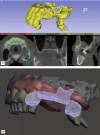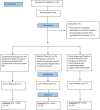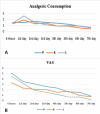Effects of Different External Sinus Lifting Techniques on Perioperative Complications and Patient Comfort
- PMID: 40320286
- PMCID: PMC12050164
- DOI: 10.1111/cid.70044
Effects of Different External Sinus Lifting Techniques on Perioperative Complications and Patient Comfort
Abstract
Aim: The objective of this study is to explore how different external sinus lifting approaches affect perioperative complications and patient comfort.
Materials and methods: This prospective, randomized, controlled clinical study was conducted with patients who were admitted for rehabilitation of the posterior maxilla and met inclusion the criteria. Sinuses to be lifted were randomized into three groups: piezosurgery with a surgical guide, a specially designed bur for lateral sinus lift, and conventional burs. Intraoperative complications, ease of access, and operation time were recorded. Pain measured with visual analog scale (VAS) and analgesic consumption were evaluated over 1 week postoperatively. Edema was evaluated preoperatively and on the 2nd and 7th postoperative days. Patient expectations, experiences, and quality of life with the OHIP-14 questionnaire were assessed preoperatively and on the 7th postoperative day.
Result: 30 sinus lifting procedures were conducted on 27 patients, comprising 16 men and 11 women. There were no statistically significant differences among the groups in terms of operation and osteotomy time, pain level, analgesic consumption, edema, patient experience, and quality of life (p > 0.05). However, significant differences were found regarding membrane elevation time (p < 0.05) and ease of access to the surgical site (p < 0.001) among the groups.
Conclusion: Piezo surgical approach assisted by a surgical guide appears advantageous in terms of operation time, surgical site accessibility, and quality of life. However, in cases where increased edema is expected, the use of specially designed burs for lateral sinus lift may be preferable.
Trial registration: ID: NCT06601816. This randomized clinical trial was not registered before participant recruitment and randomization (https://register.
Clinicaltrials: gov/prs/beta/studies/S000EWSQ00000038/recordSummary).
Keywords: comfort; guide; piezo; reamer; sinus.
© 2025 The Author(s). Clinical Implant Dentistry and Related Research published by Wiley Periodicals LLC.
Conflict of interest statement
The authors declare no conflicts of interest.
Figures



Similar articles
-
Antral membrane balloon technique versus Densah bur in crestal sinus lift with simultaneous implant placement: a randomized clinical trial.BMC Oral Health. 2024 Aug 8;24(1):916. doi: 10.1186/s12903-024-04609-8. BMC Oral Health. 2024. PMID: 39118095 Free PMC article. Clinical Trial.
-
Clinical evaluation of short 6-mm implants alone, short 8-mm implants combined with osteotome sinus floor elevation and standard 10-mm implants combined with osteotome sinus floor elevation in posterior maxillae: study protocol for a randomized controlled trial.Trials. 2015 Jul 30;16:324. doi: 10.1186/s13063-015-0853-4. Trials. 2015. PMID: 26223254 Free PMC article. Clinical Trial.
-
Cosci versus Summers technique for crestal sinus lift: 3-year results from a randomised controlled trial.Eur J Oral Implantol. 2014 Summer;7(2):129-37. Eur J Oral Implantol. 2014. PMID: 24977247 Clinical Trial.
-
Complications in sinus lifting procedures: Classification and management.Periodontol 2000. 2022 Feb;88(1):103-115. doi: 10.1111/prd.12414. Periodontol 2000. 2022. PMID: 35103321 Review.
-
Complications when augmenting the posterior maxilla.Dent Clin North Am. 2015 Jan;59(1):97-130. doi: 10.1016/j.cden.2014.09.005. Dent Clin North Am. 2015. PMID: 25434561 Review.
References
-
- Zijderveld S. A., van den Bergh J. P. A., Schulten E. A. J. M., and ten Bruggenkate C. M., “Anatomical and Surgical Findings and Complications in 100 Consecutive Maxillary Sinus Floor Elevation Procedures,” Journal of Oral and Maxillofacial Surgery 66, no. 7 (2008): 1426–1438, 10.1016/j.joms.2008.01.027. - DOI - PubMed
Publication types
MeSH terms
Associated data
Grants and funding
LinkOut - more resources
Full Text Sources
Medical
Miscellaneous

